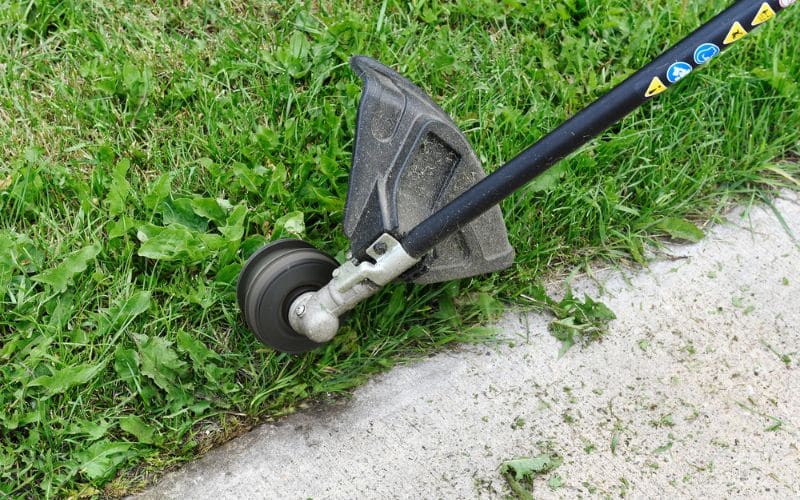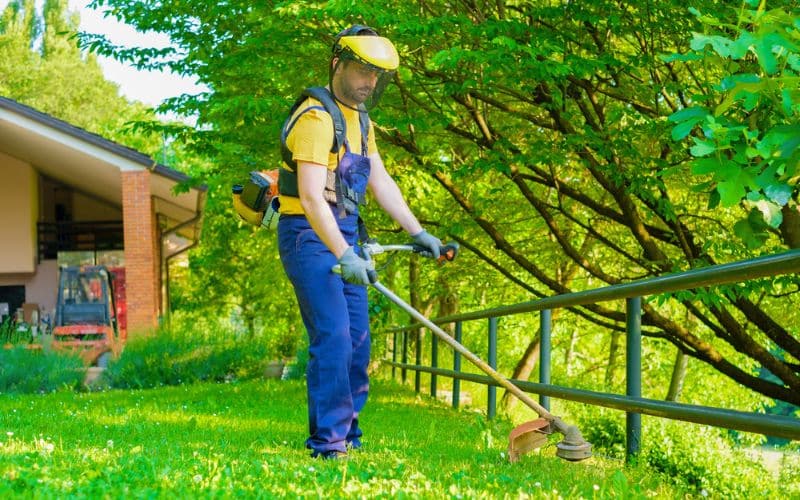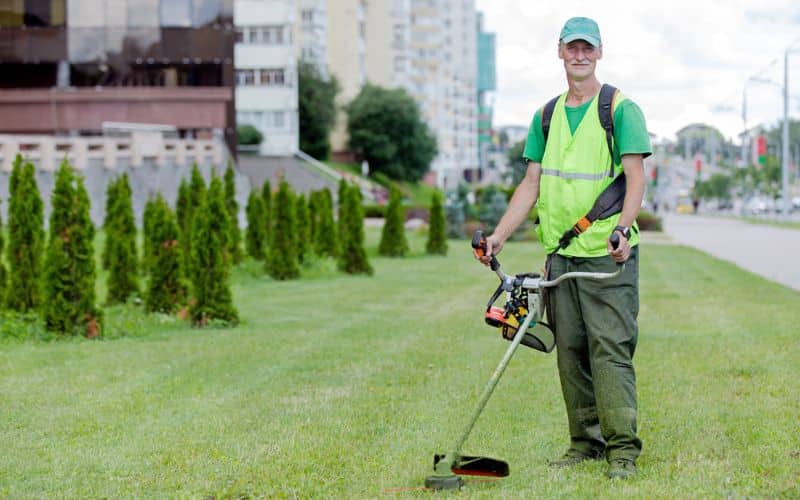
So while yes – you can indeed weed whack wet grass if necessary – I’d advise against making this common practice due its risks on both aesthetic outcome and equipment longevity.
Understanding the Dilemma: Can You Weed Whack Wet Grass?
I get asked this question a lot: “Can you weed whack wet grass?” It’s not as simple as yes or no. There are several factors to consider when deciding whether or not it’s a good idea.
First off, let’s talk about the physics of it all. When grass is wet, it becomes heavier and more likely to clump together. This means that your weed whacker might struggle to cut through efficiently. Not only can this lead to an uneven cut, but it can also overwork and potentially damage your tool.
Furthermore, safety should always be our primary concern in landscaping work – mine included! Wet conditions increase the risk of slipping while handling any power tool – including a weed whacker – which could lead to serious injuries.
Another issue with tackling damp grass is that cuttings tend to stick onto everything – from your tools right down to your shoes! They’re harder clean up compared with dry clippings and could even spread lawn diseases if left unattended.
Here are some key points for consideration:
- Wet grass makes cutting inefficient
- Increased safety risks due potential slips
- Cuttings stick easily onto surfaces
- Potential spread of lawn diseases
That said, sometimes we don’t have much choice when battling against time constraints or unpredictable weather patterns. If you absolutely must trim damp vegetation, make sure you take extra precautions such as wearing non-slip boots and cleaning equipment immediately after use.

Evaluating the Risks and Benefits of Weed Whacking Wet Grass
When it comes to maintaining your yard, timing can be everything. One question I often get asked is: “Can you weed whack wet grass?” Well, let’s dive into that. It’s a mixed bag really, with both risks and benefits attached.
Risks first. A major concern when dealing with wet grass is the potential for damage to your equipment. Water isn’t exactly a friend to most machinery, and your weed whacker isn’t an exception here. The dampness can lead to rusting of metal parts over time or even immediate motor issues in extreme cases.
Next up on the risk roster are safety hazards like slipping or tripping while maneuvering around a soggy lawn – not something we want during our weekend gardening! Moreover, wet grass tends to clump together making it more difficult for the string trimmer line to slice through cleanly; this could cause strain on both you and the machine.
Now onto the benefits side, because there are some positives too! For one thing, weed-whacking post-rainfall can actually result in healthier-looking lawns due its tendency for less dust kick-up compared dry conditions which tend towards creating airborne particles that might block sunlight from reaching plant surfaces effectively.
Here’s what I mean:
| Condition | Dust Kick-Up |
|---|---|
| Dry | High |
| Wet | Low |
Also worth mentioning is how water acts as a natural lubricant between blades and vegetation – reducing wear on machine components somewhat despite other aforementioned drawbacks tied with moisture presence!
But don’t just take my word for it; weigh these points against each other before deciding whether you’ll brave out any potential rain-soaked challenges next time those weeds start sprouting up again after an unexpected shower.
The Science Behind Why it’s a Bad Idea to Weed Whack Wet Grass
Ever wondered why you’re always advised not to weed whack wet grass? I’ve done the research, and here’s what science has to say about it.
First off, let me tell you that wet grass is slippery. This makes your task more challenging because maintaining control over the weed whacker becomes difficult. You wouldn’t want your machine sliding away from where it should be cutting! Not only does this lead to uneven trimming but there’s also an increased risk of accidents.
Then there’s the issue of how water affects cut quality. When grass is dry, its blades stand up straight which allows for a clean cut across evenly. But when wet, these blades tend to stick together or bend over making them harder targets for your trimmer line – resulting in rougher cuts and possible damage.
Also worth noting are potential problems caused by moisture interacting with your equipment:
- Increased Wear: Water acts as a lubricant between the trimmer line and grass blade during impact which can accelerate wear on both.
- Corrosion Risk: If water gets into certain parts of machinery (like metal shafts), rust could form leading eventually towards breakdowns.
Lastly, let’s talk about clumping – one nuisance most gardeners hate dealing with! Wet clippings have this nasty habit of sticking together forming hard-to-clean-up piles that may smother underlying lawn areas causing yellow spots or even worse: killing patches entirely!
| Issue | Consequence |
|---|---|
| Slippage | Uneven Trimming & Increased Accidents |
| Poor Cut Quality | Damage To Lawn & Unattractive Appearance |
| Equipment Wear & Corrosion | Shortened Machine Lifespan |
| Clumping | Yellow Spots Or Dead Patches |
So next time if someone asks you whether they can weed whack wet grass or not – just share these scientific facts behind why doing so might be a terrible idea after all!

Practical Tips for Safe and Effective Use of Your Weed Wacker on Wet Grass
You might be wondering if it’s okay to weed whack wet grass. From my years of experience in landscaping, I’ve learned that it can be done, but you need to take a few precautions. Here are some practical tips that’ll help you get the job done without damaging your lawn or equipment.
First off, wear proper protective gear. Wet grass tends to stick together and clumps up more than dry grass does. This means there’s a higher risk of debris flying around when you’re weed whacking.
Next thing is all about timing: Try not to cut your grass immediately after rain or watering – give it time to dry out slightly first! This reduces the amount of moisture being flung around by the trimmer line, making the task less messy overall.
Then there’s equipment maintenance: Clean your weed wacker thoroughly after using it on wet grass as dampness can accelerate rusting on metal parts. If left unattended, this could lead to premature wear-and-tear!
In terms of technique: Move slower than usual while cutting wet turf so that blades have ample time slicing through each blade properly instead rushing through them unevenly causing unnecessary strain on both machine & operator alike!
Lastly don’t forget about safety measures like ensuring electrical cords (if using an electric model) stay away from water bodies thus preventing any accidental electrocution incidents happening during operation hours – remember we’re dealing with electricity here folks!
By following these steps carefully:
- Wear appropriate protection
- Wait till turf dries somewhat before starting work
- Clean tool post-use especially when used under damp conditions
- Proceed at a measured pace whilst trimming
- Keep power cables far from H2O sources
I’m confident you’ll achieve better results with minimal damage inflicted upon either yourself or precious greenscape alike! Remember though always consult owner manuals prior usage since every brand/model varies slightly from one another regarding optimal operating procedures recommended by manufacturers themselves directly.
Exploring Alternative Methods: What to Do When Your Grass is Too Wet for a Weed Wacker
When you’re dealing with wet grass, it’s not always the best idea to reach for your trusty weed wacker. You may ask yourself, “Can I use my weed whacker on wet grass?” The simple answer is yes, but it isn’t recommended. Wet grass tends to clump together making it difficult for the machine blades to slice through effectively. It can also damage both your lawn and your equipment in the process.
So what should you do when faced with this dilemma? There are several alternative methods that come in handy when tackling damp greenery.
Hand Pulling: Yes, good old-fashioned elbow grease! This method can be time-consuming but highly effective if you have a smaller yard or just some problem areas.
Use of Non-Selective Herbicides: If weeds are particularly stubborn or widespread across your lawn, herbicides could be an option worth considering. Be sure though that these chemicals won’t harm other plants or pets in the area before applying them.
Hiring Professional Services: Sometimes professional help might be necessary especially if weeding has become too big of a task due to weather conditions or lack of time on your part.
| Method | Pros | Cons |
|---|---|---|
| Hand Pulling | Cost-effective; No harm caused by chemicals; Good exercise | Time-consuming; Not suitable for large yards |
| Use of Non-Selective Herbicides | Effective against stubborn weeds; Suitable for larger lawns | Can potentially harm beneficial insects and non-targeted plants |
| Hiring Professional Services | Meticulous job done by experts using proper tools | More expensive than DIY |
Choosing an alternative approach really depends on what works best given your specific circumstances — whether that means pulling out those garden gloves and getting down and dirty yourself or calling in some professional reinforcements!
It’s essential though that no matter which method you choose safety should always take precedence over everything else — protect those hands with gloves if hand pulling weeds and follow instructions carefully when handling any kind of chemical-based herbicide products.

Conclusion: Balancing Convenience, Safety, and Lawn Health
It’s been a long journey exploring the concept of weed whacking wet grass. Now that we’ve discussed it in detail, I’m ready to wrap things up.
The main takeaway here is that while it’s technically possible to use your weed whacker on damp foliage, it might not be the best idea. There are three primary considerations at play – convenience, safety and lawn health.
In terms of convenience – yes you can get rid of those pesky weeds even when they’re wet but you’ll find that the process gets messy real quick. Wet grass tends to clump together making clean-up after work more labor-intensive than usual.
When thinking about safety – remember how slippery surfaces become hazardous when using power tools? That holds true for our situation as well! The likelihood of accidents increases significantly with damp conditions so caution should be your watchword if you must go down this route.
Lastly let’s talk about lawn health – It’s crucial for me as a landscaper and should be for any homeowner too! Weed whacking soggy turf has been known to cause damage including ragged cuts which can lead to disease or pest infestations later on!
- Convenience: Possible but messy
- Safety: Risky due to slippery conditions
- Lawn Health: Potential harm caused by ragged cuts
So there we have it folks – while yes you could tackle your yard chores rain or shine; sometimes waiting out Mother Nature proves beneficial in the end.
Colin Macmillan is a seasoned entrepreneur and the CEO of Riverwood Landscape, a leading landscaping company based in Canada. He has been at the helm of the company since leaving high school, demonstrating his strong leadership skills and business acumen.
Colin’s expertise lies in various aspects of landscaping, including lawn care, interlocking, sod installation, and commercial maintenance. His hands-on approach and dedication to the craft have been instrumental in building Riverwood Landscape into a reputable brand.
One of his most notable achievements is the creation of a successful landscape franchise that services multiple locations. This accomplishment underscores his strategic thinking and ability to scale operations effectively.
Colin has also had the privilege of working with Guelph Hospital for landscaping and maintenance, a testament to the trust and reliability that his company has earned over the years.
His professional mission is to offer the best services and experiences for customers, a goal that he tirelessly pursues. Colin’s commitment to excellence and customer satisfaction continues to drive the growth and success of Riverwood Landscape.








